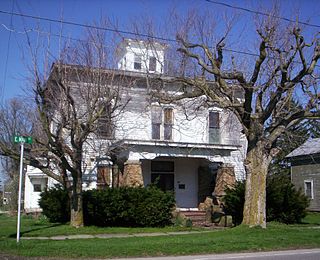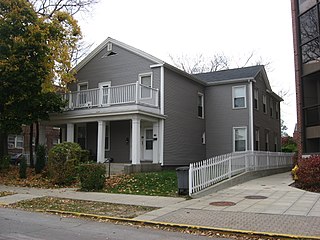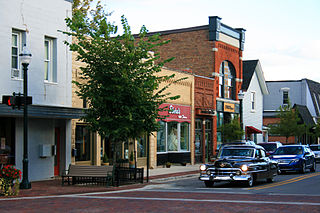
The George B. Cox House is a historic residence in Cincinnati, Ohio, United States. An Italianate building constructed in 1894, this two-and-a-half story building was built as the home of leading Hamilton County politician George B. Cox.

The Anderson–Shaffer House is a historic residence in the city of Hamilton, Ohio, United States. Constructed in the middle of the nineteenth century, it was home to a succession of owners in its early years, and it has been named a historic site.

St. Mary's Catholic Church is a historic Catholic parish church in the city of Delaware, Ohio, United States. Constructed in the 1880s, this grand building is home to a congregation established in the middle of the nineteenth century. Its grand style has long made it a community landmark, and it was named a historic landmark in 1980.

The Morgan Mansion is a historic residence in and the current city hall of Wellston, Ohio, United States. Built in 1905, it was the home of one of Jackson County's leading industrialists, T.J. Morgan, and it has been designated a historic site.

The Piety Hill Historic District is a historic district located in downtown Lapeer in Lapeer County, Michigan. It was designated as a Michigan State Historic Site and also added to the National Register of Historic Places on July 26, 1985.

The John Armstrong House is a private residential structure located at 707 Monroe Street in the city of Lapeer in Lapeer County, Michigan. It was designated as a Michigan State Historic Site and also added to the National Register of Historic Places on July 26, 1985.

The Winooski Falls Mill District is located along the Winooski River in the cities of Winooski and Burlington, Vermont, in the United States of America. It encompasses a major industrial area that developed around two sets of falls on the river in the 19th century.

The William Culbertson House is a historic residence in the village of Mechanicsburg, Ohio, United States. Constructed in the final quarter of the nineteenth century, it was once the home of one of the village's premier businessmen, and it has been named a historic site.

The Silas Ferrell House is a historic residence in the village of Shiloh, Ohio, United States. Built in the closing decades of the nineteenth century as the home of a wealthy businessman, the house exemplifies the economic prosperity of 1880s Shiloh. Its distinctive architecture has qualified it for designation as a historic site.

The Donald D. Tuttle House is a historic house at 12 Gabby Lane in Concord, New Hampshire. Built in 1933, it is a well-preserved example of a modest Cape-style house with Colonial Revival features. It is historically significant for its association with Donald D. Tuttle, who pioneered the promotion of alpine skiing in the state. The house was listed on the National Register of Historic Places in 1995. The house was moved from its original location on Pleasant Street in 2009, in order make way for a road project.

The Harrington-Smith Block, formerly known as the Strand Theater and the Manchester Opera House, is a historic commercial building at 18-25 Hanover Street in the heart of Manchester, New Hampshire. Built in 1881 to a design by John T. Fanning for two prominent local developers, the building is an expansive rendition of Queen Anne styling in brick and stone. It housed the city's premier performance venue for many years, and was an early home of the influential Manchester Union Leader, the state's major daily newspaper. The building was listed on the National Register of Historic Places in 1987.

The Queensbury Mill is a historic mill building at 1 Market Street in Somersworth, New Hampshire. Built in 1884, it is unusual for the period for its wood-frame construction, and for its financing, executed by local businessmen to attract shoe manufacturers to the city. The mill was listed on the National Register of Historic Places in 1987. The building has been converted into apartments.

The Jesse Andrew House is a historic building in West Lafayette, Indiana protected by the National Register of Historic Places because of its historic value in the time of the founding of the city. Its humble beginnings started as it was home of Jesse Andrew, a vibrant member of the early West Lafayette community. Mr. Andrews is considered to be one of the cities founders as he took a major part in the establishment of the government. The house was originally built in 1859 making it the oldest home and one of the oldest structures in the city. It went through major renovations in the 1930s, turning it into a duplex, before being sold out of the Andrew's family to a local rental company in the 1980s.

The Frog Hollow Stone Mill, or just the Stone Mill, is a historic industrial building at 3 Mill Street in Middlebury, Vermont. Built in 1840, it is an important local reminder of the town's industrial past, and was listed on the National Register of Historic Places in 1973. It presently houses a restaurant, a public market, a co-working space and four lodging units.

Grasse Mount is a campus building of the University of Vermont (UVM), which is located on 411 Main Street in Burlington, Vermont. Built in 1804 for Captain Thaddeus Tuttle (1758–1836), a local merchant, the building was designed by architect and surveyor John Johnson and constructed by carpenter Abram Stevens. By 1824, Tuttle had lost his fortune and sold the property to Vermont Governor Cornelius Van Ness. Named after French Admiral, François Joseph Paul de Grasse "Grasse Mount" was added to the National Register of Historic Places on April 11, 1973.

The James B. Dutton House was built as a single-family house located at 605 Calhoun Street in Lapeer, Michigan. It is now the Calhoun Apartments. It was listed on the National Register of Historic Places in 1985.

The Peter Van Dyke House is a single-family home, now converted into apartments, located at 1091 Pine Street in Lapeer, Michigan. It was listed on the National Register of Historic Places in 1985.

Lake Orion Historic District is a commercial and residential historic district located in Lake Orion, Michigan and roughly bounded by Elizabeth Street, Hauxwell Drive, Front Street, and Lapeer Street. It was listed on the National Register of Historic Places in 2006.

Engine House No. 6, also known as the East Franklinton Engine House, is a former Columbus Fire Department station in the East Franklinton neighborhood of Columbus, Ohio. The building was constructed in 1892, designed in the Romanesque Revival style by John Flynn. The station was decommissioned in 1966, and served as an electronics store from 1975 to 2014. It was listed on the National Register of Historic Places in 2016, accompanying planned renovations. The station has been planned to be sold since about 2016, originally to the Columbus Historical Society and Heritage Ohio, though the latter organization now plans to move to the Ohio History Center. The historical society acquired the building in November 2021, and is restoring it with plans to turn it into the city's first permanent local history museum.

The Open Air School is a historic building in the Tuttle Park area of Old North Columbus in Columbus, Ohio. The building was constructed as a school, and today houses local a café, bar, a fitness center, and event space. It was listed on the National Register of Historic Places in 2019.























